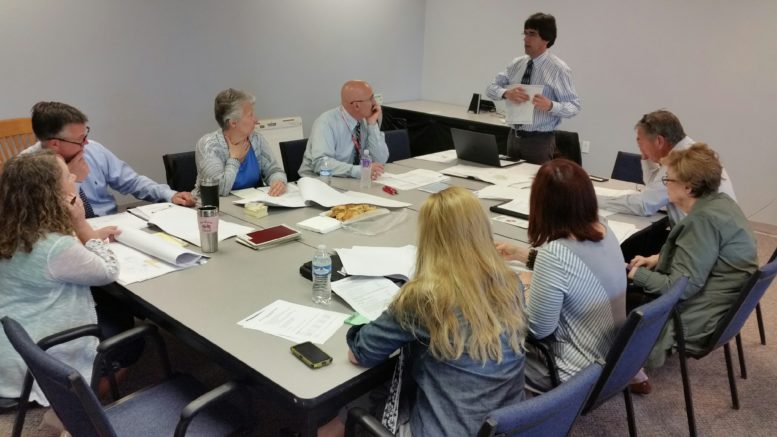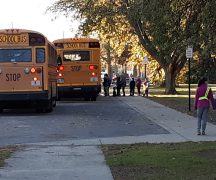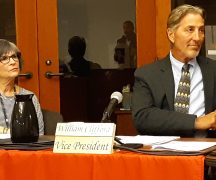By JAN LARSON McLAUGHLIN
BG Independent News
The building options for Bowling Green City Schools are gradually being narrowed down to a project that will best serve students and not scare off supporters at the voting booth.
The board of education members met Tuesday morning, and plan to make a decision during a special meeting on June 2 at 11:30 a.m., in the central administration office on Clough Street.
The two primary options left on the table are:
- Building a new centralized elementary school north of the current middle school; demolish the old elementaries; build an addition onto the middle school for the sixth grade; and partial demolition of the high school along with the construction of a new academic wing, new gym, and new cafeteria and kitchen. That option comes with an estimated price tag of $72 million.
- Building two new elementary schools at Kenwood and Conneaut; demolishing the old elementaries; plus the same middle school and high school plans as above. That option is somewhat less, estimated at $62 million.
After the board makes its final choice, the next challenge will be convincing the public to buy into the plan.
Superintendent Francis Scruci and the board agreed that just as the building option discussions have been very transparent – so will the plans and the financing.
“I think it’s vital. They need to be able to see what they are going to be investing money in,” Scruci said. And it’s important to get stakeholders on board – like teachers, students, parents and community groups.
Depending on the duration of a bond issue, the $72 million project could be financed with 6.24 mills. The $62 million option could be paid for with an estimated 5.2 mills – which may be much more appealing to voters, according to Kent Buehrer of Buehrer Group Architecture & Engineering Inc. For the owner of an average Bowling Green house valued at $165,000, the average cost for the larger project would be about $371 a year.
Put in perspective, that’s about the cost of a daily cup of coffee or a monthly pizza night, Scruci said.
And while some Bowling Green district residents already feel pinched by taxes, the school millage in the county is higher for Lake, Northwood, Perrysburg, Rossford and Fostoria.
“It will attract families,” Scruci said of new schools. “It is an investment – not only in our children and staff, but also our community.”
Bowling Green facilities not only pale in comparison to other districts when families are looking for places to settle, but the district also sees many students leave for other schools each year. Many go to Otsego and North Baltimore – which both have new facilities.
“We can’t match,” Scruci said.
“We’re faced with one of the toughest decisions – possibly one of the most game-changing decisions for the community,” Scruci said. “It’s going to take courage for the board.”
With all of the new school buildings being constructed around the region, some of Bowling Green’s buildings are now the oldest in the county. While several other districts received state funding, Bowling Green only qualifies for 11 percent state funding – which is not worth it considering all the local control that is lost once state funding is accepted.
“I’m not aware of a single district that’s partnered with OFSC at that small of a percentage,” Buehrer said.
The construction on the Bowling Green buildings could be done concurrently, lasting up to two years.
“The clock’s ticking” on the middle school expansion, with a large class in the fourth grade that would put an extra strain on the already too small middle school, Scruci said.
The board initially was considering renovations to Kenwood and Conneaut elementaries. Crim Elementary was already recently renovated. However, Buehrer voiced concerns about renovating portions of the 1950-era schools.
“The environment is not as conducive as it could be for learning,” he said. At one building, it was noted, the music teacher’s room is the old shower room. “Can you improve it to the same level of a new building? Probably not.”
If new Kenwood and Conneaut buildings are constructed, there is enough property at each school for them to be built while the existing schools are still being used.
The board members did not vote on Tuesday, but some hinted at their preferences.
Paul Walker said his original choice was major work on the high school and renovation of Conneaut and Kenwood elementaries. However a visit to Penta Career Center led him to want more for the Bowling Green students.
“But I’m sitting here thinking – what will our community support?” Walker said.
Ginny Stewart said new buildings are needed to attract younger families to Bowling Green. “If we don’t do something with our elementary schools, we are not going to attract the people we need.” Stewart said her grown children were not interested in Bowling Green because of the school facilities.
“We want this for our community, and we’re willing to make the adjustments we need to,” she said.
Bill Clifford said that new schools would benefit students and staff. “Teachers will definitely teach better,” he said.
But he also expressed concerns about local residents objecting to higher taxes. “I still get calls about our taxes being too high,” he said.
However, he added, “As a board, we don’t have a choice. We can’t do nothing.”
And the community will benefit. “We’d also attract businesses,” Clifford said. “I have a lot of hope for our community in terms of growth.”
Ellen Scholl pointed out that when the district first tried to pass a tax issue for the new middle school, people complained about the district saddling their children with debt.
Many teachers have supported the consolidated elementary concept since it will allow them to do more team teaching. But Scholl expressed some concerns about teachers truly getting to know the students when grade levels may have as many as 250 kids. She proposed that the teachers and principal follow the kids through “loop” teaching, like they do in some European nations.
Jill Carr asked that the concerns voiced by rural residents of the district be taken into consideration. “I just want to make sure we talk about the farm community,” she said.
Two citizens at Tuesday’s meeting expressed their feelings about the school building options.
Sue Smith, who has had children and grandchildren in the district, spoke strongly in favor of new buildings.
“I am definitely in favor of consolidated elementary schools,” she said. And she liked the idea of adding to and renovating the high school. “Definitely, I would vote for that. I would encourage others to vote for that as well. I’ll help you if that’s the way you choose to go.”
She currently has grandchildren at Kenwood and Conneaut.
“Those buildings are antiquated and we need to move with the times,” Smith said.
Walker told Smith he appreciated her support. “We need champions for our schools.”
Shannon Orr, whose BGSU students conducted a survey of district residents about the building options, talked about her daughter’s experience at Crim Elementary. “There’s such a sense of community,” she said.
Orr said after the recent school talent show, as students were leaving school for the weekend, half of those in her daughter’s classroom picked up tote bags of food packed for students who need food for the weekends.
While that raised questions about how much residents can afford to invest in their schools, it also raised the issue of educational needs. “These are the kids that need the best education possible,” Orr said.
Some other items discussed Tuesday included:
- The construction of a new high school gymnasium would allow the district to hold graduation on the BG campus, saving on the $3,200 annual rental cost of the Stroh Center at BGSU.
- The board seemed to lean toward hiring a construction manager to keep an eye on the projects. That could add another $2 million to $3 million on to the price tag.
- Traffic is not expected to be a problem if all the buildings were consolidated on one campus, since the school start and end times are staggered.
- If the elementaries are all consolidated, the central administration offices could move into the Crim building, which would save about $50,000 on the current rental costs.
- The district’s preschool and program for children with autism could also be located at Crim. Currently, the district loses a lot of funding for autism programming since there is no space.





